Furness Golf Club - stand up and be counted
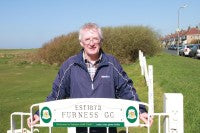 "Sometimes, the wind can be so strong that it prevents us from working on the course, as we simply cannot stand up!"
"Sometimes, the wind can be so strong that it prevents us from working on the course, as we simply cannot stand up!"
Alick Mackay's first words are; "On a clear day, you can see the Isle of Man, but we don't get many of those here, and you are very lucky that this is one of those clear days." Indeed, the views from this old links course, the sixth oldest club in England, are quite stunning, with panoramic views across Morecambe Bay in one direction, and the peaks of the Lake District in another. Depending on your viewpoint, there is also the 'spectacle' of one of the largest off shore wind farms to delight the senses.
The town of Barrow-in-Furness, more commonly known simply as Barrow, is famous for its shipbuilding legacy. Its location, and the availability of steel, allowed the town to develop into a significant producer of naval vessels, a shift that was accelerated during the First World War, and the local yard's specialisation in submarines. 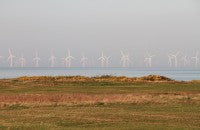 The original iron and steel making enterprises closed down after World War II, leaving the Vickers boat building factory as Barrow's main industry and employer.
The original iron and steel making enterprises closed down after World War II, leaving the Vickers boat building factory as Barrow's main industry and employer.
The Royal Navy flagships HMS Hermes, HMS Invincible and HMS Albion, as well as all four Vanguard class submarines (which carry Trident nuclear weapons), were manufactured at the facility. From the 1960s, the shipyard increasingly specialised in the construction of nuclear-powered submarines. However, with the end of the Cold War and the subsequent decrease in military spending, the town suffered high unemployment through lack of contracts. Despite this, the shipyard remains operational, and the only submarine production facility in the UK, but the number of people employed has shrunk from over 15,000 to under 5,000.
Founded in 1872, Furness Golf Club, appropriately for a shipbuilding town, used a deck cabin from one of the old Clan liners as its first clubhouse. A bridge erected across Walney Channel to Walney Island in 1908 replaced the ferry and added to the attraction of the club and, commensurate with the club's growing status, a new clubhouse was opened on the 8th January 1916.
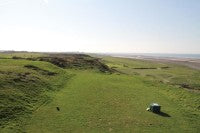 During World War II, the course formed part of the coastal defences and was known as Fort Walney. Today, the members still play for the Fort Tankard, whilst the original gun emplacements are protected buildings and form a feature of the course.
During World War II, the course formed part of the coastal defences and was known as Fort Walney. Today, the members still play for the Fort Tankard, whilst the original gun emplacements are protected buildings and form a feature of the course.
Alick Mackay came to the club seven years ago, having previously worked at The Hotchkin Course Woodhall Spa, Machrihanish, Carnegie Club at Skibo Castle, Boat of Garten and Royal Dornoch golf clubs, the latter where he was inspired by the late Hunter Donaldson.
As we walked the course, Alick continued to point out how lucky I was with the weather - little or no wind, and it wasn't raining! He showed me the rainfall figures for last year; around 4" (100mm) per month is the average. "It can be a tough place to grow grass," says Alick. "The combination of wind speeds, salt spray and heavy rainfall makes it a difficult course to manage at the best of times. In addition, the course is built over two distinct soil types - clay and sand - with the clay soil creating drainage issues in the winter."
"But, it is the constant battering by the westerly winds that cause the most damage," exclaims Alick, "bringing in sand from the beaches and regular blasts of salt 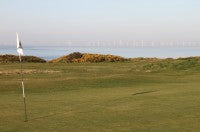 spray. Sometimes, the wind can be so strong during harsh times in the winter that it prevents us from working on the course, as we simply cannot stand up!"
spray. Sometimes, the wind can be so strong during harsh times in the winter that it prevents us from working on the course, as we simply cannot stand up!"
"Wind chill also means that any real grass growth does not occur until mid April when soil temperatures eventually struggle into double figures. I monitor soil temperatures on the greens, using a soil thermometer, and it's the same every year."
There are three full-time staff (including Alick) plus a seasonal worker for the summer months. This year they have acquired the services of David Shepherd, the former Barrow-in-Furness FC's head groundsman.
Alick's first assistant is Adam Britchford, who has been at the club for twelve and a half years, whilst greenkeeper, Rob Leitch, joined the team eight months ago.
"When I came to the course back in 2004, many parts were devoid of grass cover, particularly the high spots on fairways and greens," declares Alick. "So I called on the assistance of Henry Bechelet (STRI) and Jayne Leyland who, at the time, was working for Barenbrug. Raising the height of cut and following some reseeding recommendations from Henry and Jayne soon helped."

"Soil tests confirmed that fescue and bent grasses were, in general, best suited to the course's sand and clay soil. However, the introduction of unique, site-specific species would also prove essential in order to cope with some of the extreme environmental stresses identified throughout the golf course."
"By considering the environmental pressures that affect individual areas, we put together mixtures to withstand the course conditions. The clay tends to dry out in the summer, and the ferocity of the wind on the sand also makes for difficult conditions," Alick explains. "There's barely a calm day here! We're also without irrigation on most of the tees, which is a factor. But the mixtures Jayne came up with have been a success, and we now have full coverage."
A prime example of finding a mixture to suit Furness' extreme conditions is the use of Barenbrug's ultra low-input drought and salt tolerant BAR 40 on a very exposed, problem tee. "This particular tee, the eighth, is battered by wind, rain and salt-spray; it's very exposed," says Alick. "There's no shelter from dunes or anything. But the mixture is working a treat."
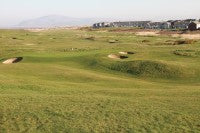 The remaining tees have been sown with fast-establishing, fine-leafed varieties, which combine perennial ryegrass with slender creeping red and Chewings fescues. The greens, meanwhile, have been sown with a variety of mixtures to suit their different needs - seven are benefitting from BAR Trio, which Alick says is "working well", a further ten have been sown with BAR All Bent and the remaining greens with BAR 22, which contains a hard fescue.
The remaining tees have been sown with fast-establishing, fine-leafed varieties, which combine perennial ryegrass with slender creeping red and Chewings fescues. The greens, meanwhile, have been sown with a variety of mixtures to suit their different needs - seven are benefitting from BAR Trio, which Alick says is "working well", a further ten have been sown with BAR All Bent and the remaining greens with BAR 22, which contains a hard fescue.
"Our greens range from being very wet to being very dry," Alick explains, "hence using the different mixtures. The weather really does dictate everything for us. Jayne recognised this and so, if a mixture wasn't working, it was re-jigged to suit."
In addition, a solution has also been found for Furness' wind-burnt fairways by using a 100 percent fescue mixture containing Hardtop hard fescue that copes well with the extreme conditions of this particular area. Perennial ryegrass mixture BAR Extreme, with its outstanding wear-tolerance and recovery, has also helped improve Furness' fairways in heavily trafficked areas.
 Alick's willingness to try new mixtures and cultivars has been key to the success of this project. "Some people sit on the fence and just use traditional mixtures, but it's important to try new things to see what will suit different conditions and climates," he argues. "Personally, I'd like to use just fescues and bents throughout the course, but some of the mixtures have other species in, and this just goes to show that you can't always have what you want. You have to look at the alternatives available. The mixtures have been a success and we've now got full grass cover. You have to be open-minded."
Alick's willingness to try new mixtures and cultivars has been key to the success of this project. "Some people sit on the fence and just use traditional mixtures, but it's important to try new things to see what will suit different conditions and climates," he argues. "Personally, I'd like to use just fescues and bents throughout the course, but some of the mixtures have other species in, and this just goes to show that you can't always have what you want. You have to look at the alternatives available. The mixtures have been a success and we've now got full grass cover. You have to be open-minded."
The rewards for changing the maintenance regimes, in terms of raising mowing heights and committing to a reseeding programme, has paid dividends in terms of producing a better, more playable golf course.
Alick's maintenance regime is tailored to meet the demands of the course and fit in with the resources he has available. "Only having three staff generally dictates what we can achieve," he says, "so, time is focused on greens, tees and the general presentation of the course."
"We cut the greens at 4mm in the summer, raising them to 6mm in the winter, using the John Deere 2500B triple. Tees are kept between 8-10mm, as are the collars. 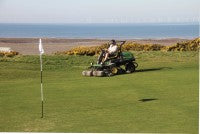 Both are cut with the John Deere 2500A, although we do also use the 260C pedestrian mower on the collars."
Both are cut with the John Deere 2500A, although we do also use the 260C pedestrian mower on the collars."
"Surrounds are kept at 10-12mm using our John Deere 2653A; fairways are cut at 14mm with the John Deere 3235C, and the semi-rough 50mm with the 3245C."
"Aeration work varies from verti-draining greens and tees to the usual slit, hollow, solid-tining and also star and pencil tining on greens. We use the Imants Shockwave on our fairways."
"We put a lawn sand on the greens in spring, plus Vitax 8+0+6 in spring and summer. Tonics used are Award Surf to Turf, Triple Seaweed, Prosward HighK (5+0+20), Ironmax PlusK and, just lately, we have been using Green On liquid 5+0+12 plus 8.75Fe."
"We are topdressing, at present, with straight sand and also Whitemoss's Greens 3 topdressing."
"Weed control on the greens is usually done by hand, whereas, for collars, tees, fairways etc., we use New Estermone."
 "Fusarium, Dollar Spot and Red Thread are the most common diseases but, in 2010, we also had some Pink Patch. We generally only spray once a year for these diseases but, recently, have managed to go a period of twenty-six months without having to spray any fungicide. I believe in letting nature run its course in certain environments."
"Fusarium, Dollar Spot and Red Thread are the most common diseases but, in 2010, we also had some Pink Patch. We generally only spray once a year for these diseases but, recently, have managed to go a period of twenty-six months without having to spray any fungicide. I believe in letting nature run its course in certain environments."
"Some rough and heather are left uncut, providing habitat for a variety of wild life. Pheasant, duck, kestrel, sparrows, larks, and the occasional deer are seen on the course, as are our main pest, rabbits. We do see the odd fox, but even they don't seem to like the weather here!"
"We occasionally spray for chafer grubs on the greens, but they are not a huge problem."
"Depth of drains and rootzones vary from area to area on this site. We have automatic irrigation to all greens and some tees."
Alick reports to a Greens Chairman, currently Gordon Walker, to get approval for funds to improve and maintain the course. "So far, we have been well supported by the club with our machinery requirements. Most is purchased from John Deere dealers, Armers of Leece."
"I realise that, like many other clubs, we are under great pressure to retain and improve membership numbers, and I believe that the presentation of the course goes a long way to achieving those goals. The work we have undertaken with the STRI and Barenbrug has certainly opened my eyes to what can be achieved on a site 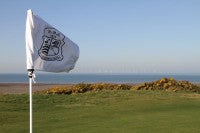 influenced, so much, by the local weather conditions. We are indebted to Henry Bechelet of STRI for his enthusiasm, Jayne Leyland for her inspirational input, and Nigel Hurst for his advice on machinery."
influenced, so much, by the local weather conditions. We are indebted to Henry Bechelet of STRI for his enthusiasm, Jayne Leyland for her inspirational input, and Nigel Hurst for his advice on machinery."
Fittingly, the club's crest depicts, as well as a bee and arrow (for Barrow), the sea, and a ram's head in honour of the town's first mayor and club President, John Ramsden, a rather wind-blown flag on a green. Proof, if it were needed, that this truly is a club facing all that Mother Nature can throw at it.
Furness is a proper rugged seaside course, with proper weather to test the golfers; and a proper head greenkeeper who appears to be enjoying the challenge of bringing the course back to top condition - perfect timing for all the events surrounding their 140th anniversary.
 What's in the shed?
What's in the shed?
John Deere 2500B Greensmower
John Deere 220 Pedestrian mowers x2
John Deere 2500A Tees and Collars,
John Deere 260C pedestrian mower for tees and collars
John Deere 2500 verti-cutting and vibrating rollers
John Deere 2653A utility mower
John Deere 3235C fairway mower
John Deere 3245C Roughcutter
John Deere 1750 tractor
John Deere 4320 tractor
John Deere 855 tractor plus front loader
John Deere Gator
Sisis Powa Spred topdresser
Ryan turfcutter
Hardi power sprayer
Stihl strimmers x 3
Flymo Hovertrim 450 x 2
Multi-core aerator,
Charterhouse Redexim seeder/topdresser
